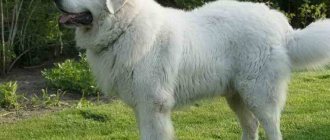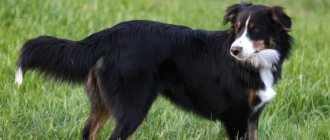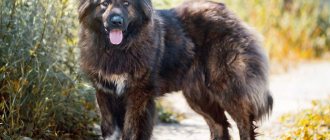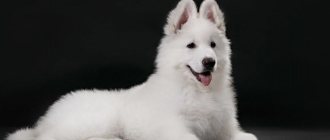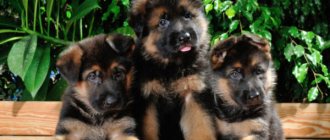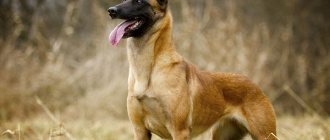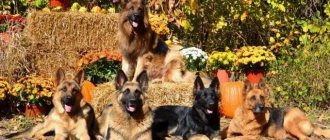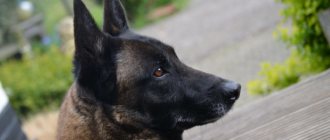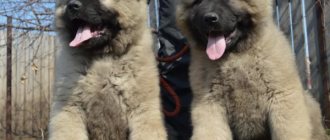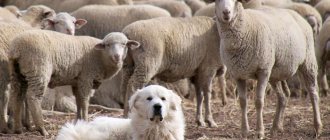Breed characteristics
| Short description | |
| Origin: | Great Britain |
| Conditions of detention: | Apartment or house |
| Purpose: | Shepherd; companion |
| Color: | Tricolor and bicolor |
| Wool length: | About 12 cm |
| Adult dog size: | Weight from 5 to 12 kg, height from 35 to 40 cm |
| Average life expectancy: | 14 – 16 years old |
| Walk: | Walking twice a day is required |
| Physical activity needs: | Activity level is high, but can get by with 2 – 3 hours a day |
| Fédération Cynologique Internationale (FIC) classification: | Group 1 – herding and cattle dogs except Swiss cattle dogs; section 1 – shepherd dogs |
| Puppy price: | From 15,000 rubles to 35,000 rubles |
History of the breed
The breed is considered relatively young. It was officially registered at the beginning of the 20th century. The homeland of the animals is the Shetland Islands, and the ancestors of dogs of several groups are considered: Norwegian Buhunds, Yukis, Icelandic Shepherds and Spitz.
Mini collie is a herding dog, which peasants called nothing more than “tiny dog,” which translated means “tiny dog,” that is, a small collie. The pets helped herd the animals and also moved them. Over time, having appreciated the working qualities of the Sheltie Collie, peasants began to use them as guards.
The breed first became known in the 19th century, when guests on the islands began to pay attention to the dogs and asked local residents to sell them. Having realized that puppies bring good income, their breeding was put on stream. However, breeders continued to improve the breed. The official standard was established in the 20th century.
During the First and Second World Wars, breeding of pets was suspended and the breed was on the verge of extinction. But after the war, several of its representatives remained and selection was resumed.
Important! The breed's popularity increased in 2005 after the release of the film Lassie.
History of the origin of the species
The true history of the origin of the Sheltie is not known; historians and zoologists have several different opinions. One thing is certain: the breed was bred on the Shetland Islands.
160 kilometers from the coast of Scotland, at the intersection of the North Sea and the Atlantic Ocean, there are 10 small Shetland islands. It was there that the Shetland Sheepdog breed originated.
Many people confuse Sheltie with Collie; they do have a striking resemblance in appearance, but are two completely different breeds. Moreover, the collie did not become the basis of the genetic code for the Sheltie.
The harsh climate of the Shetland Islands did not allow the local population to engage in anything other than cattle breeding. The residents needed a dog that could handle a small flock of sheep. It is unprofitable to keep a large shepherd dog for such purposes. That's how the Sheltie appeared.
If you carefully examine the dog, it clearly shows Spitz-like features - a shortened muzzle, small ears and a protruding chest. Northern Spitz-types became the progenitors of the breed. During the selection process, the Shetland Sheepdogs were supplemented with the blood of Greenland Cattle Dogs, Spaniels and Schipperkes. Lastly, in the 19th century, the genetics of long-haired collies were added, and then the breed acquired its final form.
The breeders have created an excellent, vigilant shepherd's assistant. Which, despite its compact size, managed the herd perfectly. In addition, he had such a beautiful and aristocratic appearance that they began to export him to the continent as an expensive gift.
The first breed standard was registered in 1948, by which time the breed had finally formed and acquired a form that has remained almost unchanged to this day.
The first specimens were brought to Russia in 1994 , but despite all their positive qualities, they never gained widespread popularity. But those who at least once got themselves a Sheltie no longer betray this breed.
Video
* We invite you to watch a video about the Sheltie . In fact, in front of you is a playlist in which you can select and watch any of 20 videos about a given dog breed by simply clicking on the button in the upper right corner of the window. In addition, the material contains quite a lot of photos. By looking at them you can find out what a Sheltie looks like.
In this article:
|
Rate the material!
[Total votes: 2 Average: 3]
Distinctive features
The main distinctive features of the Sheltie:
- General form. A small, well-proportioned dog with thick, long hair. The movements are light and relaxed.
- Height. Height at the withers for males is 36 – 39 cm, for females 35 – 37 cm
- Head. Small, wedge-shaped, tapering towards the nose. The occipital protuberance is not pronounced, the cheekbones are flat, the transition from the forehead to the muzzle is moderately pronounced. The eyes are slightly slanted, symmetrically located, almond-shaped, brown or blue in color. The ears are small, semi-erect.
- Muzzle. Narrow, nose black, lips close-fitting, black, head and muzzle equal in length. Scissor bite, teeth tightly clenched.
- Neck. Dry, without dewlap, with pronounced muscles, slightly curved, which gives the dog an aristocratic appearance.
- Frame. Compact, lightweight, free from dampness. The stomach is tucked in, the back is straight, the lower back is moderately rounded. The ribs protrude slightly, the chest is narrow, dropped below the elbows.
- Limbs. Straight, light, rounded pasterns, fingers closed. The thighs are strong, muscular, but tight, without dampness. Shoulders and shoulder blades of equal length. The shoulders are set obliquely, tilted back.
- Tail. Long, low set, profusely pubescent, never rising above the level of the back. The tail length is ideally slightly below the hock joint.
- Coat and color. Two-layer, very thick. The undercoat is light but abundant. The guard coat is long and moderately hard. Longer on the tail and chest than along the body. Bicolor color options - black and white, red and white; tricolor - black and white with red tan, sable, blue merle, bi-merle.
- Sexual dimorphism. Pronounced, females are much more compact and “feminine” than males.
Appearance
In appearance, Shelties resemble the famous collie. The Sheltie breed has a pretty appearance. She looks dignified and aristocratic in English. The Sheltie's head is elongated and the nose is elongated. There is an abundant mane on the head. The jaws are well developed, the bite is correct, the lips are closed. The eyes are almond-shaped, slanted. The eye color is mostly brown, but can be blue (or one eye can be brown and the other blue) if it is a merle color. The ears are small in size, set high and close to each other.
The tip of the ear is bent. The neck is well developed. The body is slightly longer than the height of the withers, the top line of the body is straight. The limbs are developed and muscular. Paws are oval shaped. The tail is densely covered with hair and set low. Body movements are elegant and graceful. The dog is very active: it jumps well and runs quickly.
Photo of an adult dog
Sheltie character and communication
As for the intelligence and character of the Sheltie, the pros and cons of the breed are directly related to their origin. Dogs of this breed are playful and friendly, emotionally attached to people, and therefore are good as companions for adults and children. But they are practically useless as nanny dogs, since they do not perceive people as objects of supervision. Sociability is expressed in the willingness to follow the owner, participate in games and walks, express emotions with sounds and body movements. This is a rather “talkative” breed, so if you really like silence, then either get yourself a pet of a different breed or begin to gently teach your Sheltie to restrain its barking from a young age.
Photos of puppies
Features of character and behavior
The Sheltie is a versatile dog. Suitable for all types of owners, both for single people and for large families with small children. Can live in a small apartment and in a large house. The only thing they cannot do without is the attention of the owner.
Shetland Sheepdogs are considered one of the most intelligent dogs. They are among the top 10 easiest to train breeds, occupying an honorable 6th place in this ranking.
Affectionate, good-natured, intelligent pets, incredibly attached to their family, can become excellent nannies for small children. They treat outsiders coldly, with some mistrust, but without unnecessary aggression.
Recipients of 5 stars for communication skills. They can get along with any other animals. Those with whom they live under the same roof are loved selflessly, be it a cat, goose, dog or lizard. The rest are treated indifferently.
They are distinguished by exceptional working qualities, even though they have not worked as shepherds for a long time. The instinct is so strong that you don’t have to worry about a Sheltie while walking; she won’t run away and will carefully graze her owner. They graze the members of their flock family, including all the living creatures living in the house.
The Shetland Sheepdog will not make a good guard dog, but will gladly let its owner know that a stranger is approaching its territory. It is believed that this breed is very noisy, barks a lot and loudly. But unique training abilities can correct this if the owner shows his dissatisfaction with the behavior - the dog will not bark in vain.
Advantages
The main positive qualities of the breed include:
- Mind;
- Obedience;
- Not prone to running away;
- Excellent working qualities;
- Desire to please the owner;
- Attachment to the owner;
- High level of communication skills;
- Excellent training abilities;
- Wary of strangers;
- Suitable for beginner dog owners;
- Unpretentious to living conditions.
The list of Sheltie's advantages can be continued endlessly; there are few breeds in the world that are so universal.
Flaws
The main negative features of this breed include:
- Excessive attachment to the owner can lead to depression;
- They require a lot of attention;
- Not suitable for security;
- Wool needs special care.
You won't find any more faults in a Sheltie.
Pros and cons of Sheltie
Despite their visual attractiveness, Sheltie dogs have a number of specific disadvantages. The main one is the predisposition to a large list of various diseases. Many dogs of this breed are susceptible to allergies, cataracts, hip dysplasia and various tumors. However, most Sheltie dogs still have good health and high immunity.
The downside of the breed is that it is difficult to care for. The main difficulty lies in caring for the dog's long and thick hair. The pet needs to be brushed and bathed often. He needs quality dog care products. In addition, you will have to endure molting twice a year. The Shetland Sheepdog sheds a lot. If you suffer from allergies, then this dog is definitely not suitable for you.
Otherwise, Sheltie dogs are excellent. They are devoted to their owner, adore children, are obedient and smart. Such a pet will become a guard for the home, a best friend or just a companion in life. Sheltie is unpretentious to food and living conditions. The animal can withstand almost any climatic conditions. Thick fur helps him with this. It saves him from both frost and overheating.
Among the advantages, one cannot fail to note the dog’s stunning exterior. The pet is small, has a luxurious coat and a cute face. The dog's energy is also a plus. Shelties are almost always in a good mood, they are active and playful. They love to walk, learn and carry out various tasks for their owner. The main thing is to devote time to the dog and train him from an early age.
Care and maintenance
One of the most unpretentious dogs to keep. It can live in any living conditions, on any territory, in any climate, the main thing is to be closer to people.
Needs active games, moderate physical activity, loves to frolic in the snow, and is not afraid of frost. But if the owner is not in the mood, he will happily just wander around, without pestering him with calls to play.
Caring for your eyes and ears doesn't require much effort. It is enough to stock up on hygiene lotions for these organs. And about once a week or a week and a half, wipe your eyes and ears with a swab dipped in a solution intended for the eyes or ears, respectively.
The claws also do not need to be looked after in any special way. Trim nails as needed. If your dog often walks on asphalt roads or paving slabs, you may be able to forget about trimming his nails completely. Residents of rural areas will have to trim their claws approximately once a month using special forceps (claw clippers).
Nutrition
Breeders of Shetland Sheepdogs strongly recommend feeding them with ready-made, balanced food. The Sheltie has sensitive digestion, like many breeding Sheepdogs. It is difficult to create a complete diet that will not lead to stomach problems on your own. Therefore, you should not save money; it is better to turn to professionals who have developed food for miniature breeds.
The Shetland Sheepdog is not on the list of gluttons; on average, an adult eats about 3 kilograms of dry food per month. This is not much, and even high-end food from a well-known brand will not hit the owner’s wallet.
We recommend that you read a detailed article on the topic: “How and what to feed a dog: types and characteristics of nutrition.”
Health
Sheltie dogs can be safely classified as healthy dogs. Moreover, they are long-lived in the dog world. Some individuals live up to 20 years . And the average life expectancy is considered to be 14 – 16 years .
With the right approach to maintenance and nutrition, no particularly terrible diseases have been identified in Shetland Sheepdogs. The main thing is a well-chosen diet, moderate physical and mental stress.
Vaccinations
- At the age of 6–8 weeks, the breeder administers worm prevention to the entire litter, including the female. After 10–14 days, the procedure is repeated.
- Then, after another 10 days , the first vaccination against hepatitis, enteritis, and plague (Carré disease) is given. Additionally, your veterinarian may prescribe another vaccine against a disease specific to a particular region.
- After 28 - 30 days , a double vaccination is given to enhance the result. If the puppy is healthy and active, they immediately give an injection for rabies. Otherwise, the doctor may postpone the rabies vaccination until the teeth are completely replaced. After the second vaccination, it is recommended to observe another 2 weeks of quarantine.
- The last puppy vaccination is given at the age of 8 - 12 months . Then, every year, they give one injection against rabies and against viral infections.
During the days of vaccinations and taking deworming medication, the dog may experience lethargy, drowsiness, lack of interest in active games, a one-time refusal to feed, and even a single vomiting.
Important article on the topic: “Everything you need to know about dog vaccinations.”
Allergic reactions to modern drugs practically do not happen.
Diseases
Sheltie is not a commercial breed; for the most part, breeders really care about the dogs and are trying to make the livestock healthier. But a large number of mixtures of different genetic codes and an inept approach to inbreeding in the 18th century still gave rise to several diseases, the tendency for which can be seen in modern Shelties.
Common diseases:
- Arthritis (in larger individuals);
- Excess weight (due to improper diet or low physical activity);
- Cataract;
- Retinal degeneration;
- Glaucoma.
I would like to note the frequent rejection of the size standard . Shetland Sheepdogs often outgrow the height limit at the withers.
Walk
Shelties love active recreation . They love to run, jump, and frolic. It has been noticed that even with the onset of old age, they remain playful puppies. But the desire to please the owner forces dogs of this breed to adopt the habits of the owner.
Once in a family where a calm, phlegmatic atmosphere reigns, the Sheltie becomes just as calm and peaceful.
But you shouldn’t abuse your pet’s flexibility. For the normal formation of joints and skeleton, they need physical activity.
Grooming
Grooming requires special attention. Shelties need to be brushed at least twice a week. During the molting period, to avoid the formation of tangles - every day.
To prevent your entire house from becoming covered in hair, you need to acquire a whole arsenal of grooming supplies. Modern pet stores offer them in a wide range.
Necessary equipment for grooming:
- Furminator;
- Massage brush with fine teeth;
- Colt cutter;
- Puhoderka;
- Long-toothed comb;
- A brush with sparse and short teeth.
Under no circumstances should you cut your Sheltie's hair! Their fur no longer grows to the desired length. The dog remains a breed defect.
Washing a long-haired pet is a real challenge. In winter, Shelties do not need to be washed at all, this is fraught with colds. After washing, do not use a hair dryer. Its use causes the guard coat to become overdried and brittle.
The ideal option for drying a dog is a special groomer compressor. It blows out tiny droplets of water from the undercoat and does not harm the guard coat.
We must remember that after bathing, the thick mane of a Shetland Sheepdog completely dries out within 3 days. This cannot be ignored during winter hygiene procedures.
Content
- What is color and suit in dogs
- Sheltie breed colors
- How to choose a healthy puppy
When a person chooses a pet, he gives preference not only to a certain breed, but also focuses his attention on the color (in this case, choosing a Sheltie puppy), it comes in different shades and colors, striking with its beautiful patterns and appearance. Genetics is one of the main points in a dog’s appearance; color, type of coat and proportions depend on it.
Mating
Dogs over 18 months old are allowed to breed. In females, as a rule, this is the third sexual heat. The first estrus occurs at the age of 6 to 9 months , depending on the characteristics of the body.
Shelties are bred on the 10th – 12th day of estrus – these are approximate data. Ovulation can occur on the 15th – 18th day of sexual heat, because these are living organisms, it is impossible to accurately predict. A dog does not need to select a time for mating.
Shetland Sheepdogs have a very wide range in the number of puppies per litter. One female can bear 3 - 4 puppies , the other safely gives birth to 6 - 7 .
Before mating, it is recommended that the dog and bitch undergo deworming in order to prevent infection of the offspring.
Read a detailed article on the topic: “Everything you need to know about breeding dogs: appropriate age, what to do if it doesn’t work out, rules and tips.”
Health and illness
Every lover of this breed often encounters a number of problems with their pet, because the breed is quite painful. The main diseases are as follows:
- bladder cancer and other cancers;
- von Willebrand disease;
- joint diseases;
- polyarthritis;
- weakening of ligaments;
- gastroenteritis;
- dermatomyositis;
- deafness, most often congenital;
- vision problems;
- cryptorchidism
Important! Representatives of this breed have genetic intolerance to Milbemycin and Ivermectin.
Lifespan and reproduction
The average lifespan of these animals is 12-14 years. The bitch is mated 9-14 days after the start of her heat. Only healthy animals are allowed to mate.
Key points in training
Raising a Sheltie is not difficult; even a beginner can handle it. Thanks to their great desire to please their owner, little collie clones will show remarkable obedience. Even children can train Shetland Sheepdogs.
Professional trainers can hope to win prizes in training competitions. Shelties can successfully run agility courses, win in dog frisbee, freestyle, and obedience. Only competitions that include tests of guarding qualities are not suitable for small shepherds.
Read about how to properly train a dog in the article: “Training a puppy: effective methods from dog handlers, learning commands at home.”
Only humane training methods are suitable for Shelties..
When corrective equipment or harsh punishment methods are used, the dog can become intimidated and angry. Contact with the trainer will be lost and will have to be restored for a long time.
Education and training
The key to proper upbringing and productive training is a strong relationship with the owner. Shelties absolutely cannot tolerate physical violence being used against them, so being rude is prohibited. It is enough to point out mistakes with your behavior and praise if the dog follows the command correctly.
It is especially important to teach your pet the following commands:
- "Ugh".
- "Quiet".
- "Voice".
- "It is forbidden".
- "To me".
Important! For training to be effective, you should treat your pet with treats for correctly executed commands.
How to choose a puppy
Since the Sheltie is not a commercial breed, the danger of buying a sick puppy is minimized. But you still shouldn’t go to the poultry market to buy a purebred dog; good breeders don’t sell their puppies there.
First you need to determine the purpose for which you are purchasing a pet. If this is a favorite of family and children or a reliable companion for a lonely person, then you can search for the nearest breeder on the Internet.
If you need a dog with show potential or a farm assistant. It’s definitely worth going to a major exhibition and looking for a breeder there.
Nursery owners are worried about their “children” for this reason, they are willing to make contact, and answer all questions with pleasure. They are happy to help you choose food, supervise at exhibitions, and help solve any difficulties that arise.
Sheltie will warm your heart in bad weather. Ready to be there in any situation: to cheer you up when you’re sad; calm down when anxious; protect when you're scared. The owner of a Shetland Sheepdog is not in danger of loneliness - she will always be there.
What is the color and color of Sheltie dogs?
The visible pigment of the outer part of the hair. A significant number of dogs, along with pigmented hair, have white spots or marks in certain areas of the body that are devoid of pigment, i.e. hair lacking pigment. When mixing colors, the color of the dog is determined by the dominant color. A dog has such types of hair as downy, integumentary (smooth), guard hair. The different properties of wool are determined as an adaptation to different climatic conditions and their habitat. Each type of coat and its color requires special care. Breeders have studied how color and patterns are created on the body of an animal. Genes can be responsible for hair structure and color. This is general information that applies to all dog breeds, not Sheltie puppies.
- A. With the help of this locus, a solid color of the pet’s entire body is obtained (monochromatic).
- B. Dyes wool black. Some species have partial of this gene (spotting). Some dog breeds necessarily have this gene!
- C. This is the key component! With its help, the body produces color throughout the body. If this component is missing, the dog may be born without color (albino). The color of the nose and iris does not depend on this component.
- D. If there is little gene in the pet’s body, then the coat will be lighter. If there is a lot of gene in the body, then the dog will have a rich black color. The gene affects the viability of the dog; if a pet is born with a lack of the gene and a blue color, then he may most likely not live to see his senior years. When the gene is dominant, the color of the pet turns out to be black.
- G. With old age, this component is activated and gray hair appears. They call him gray-haired. When the color turns gray.
- E. With its help, in most cases, three-color colors are obtained, containing pigment of black, brown and yellow.
- M. The gene leads to anomalies for the pet and gives a harlequin pattern. Has a marble color. With old age, the gene can lead to lightening of color.
- S. This gene causes partial body pigmentation in dogs. (white spotting).
- T. The gene is characterized by mottling. It is opposite to the S gene and forms dark spots on white areas.
- R. Chastity - alternation of hair that is colored and not.
